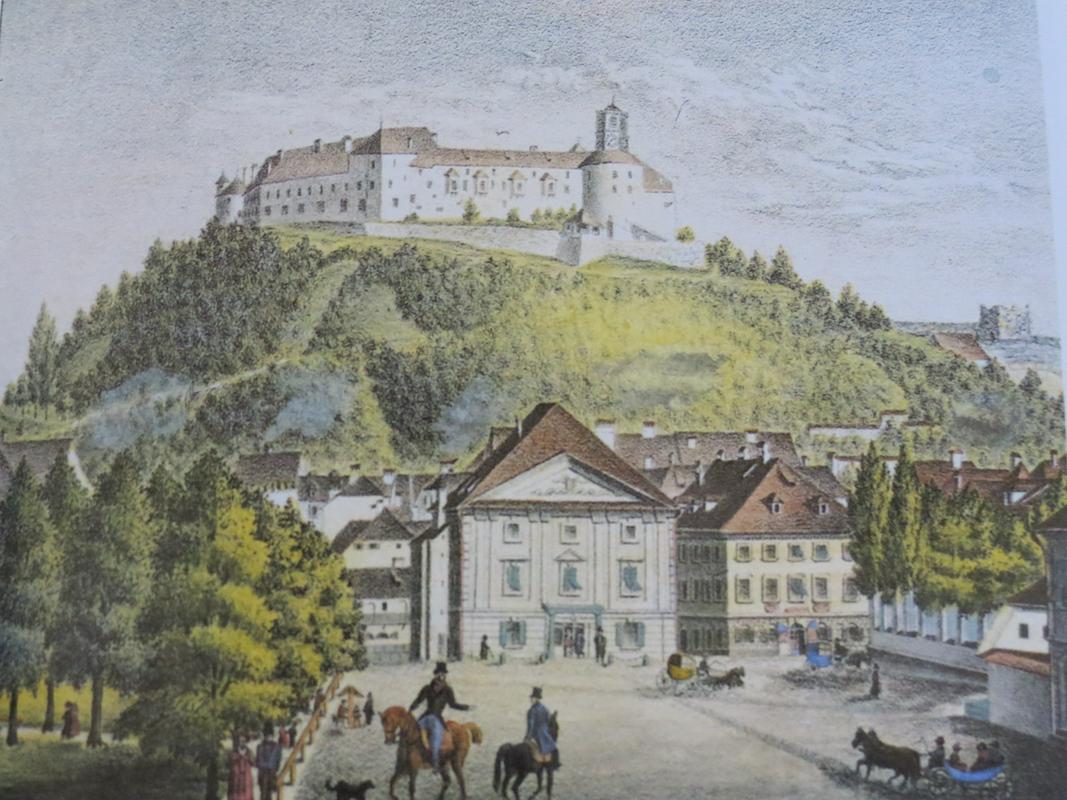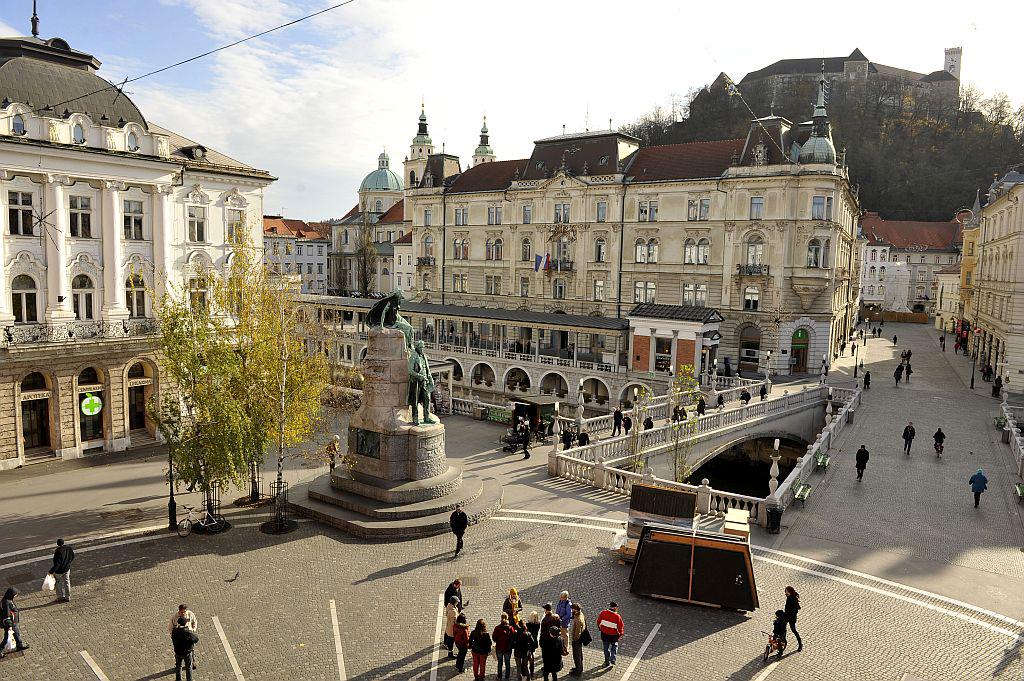

When the first sidewalks were built in Ljubljana, people refused to use them, because they were not accustomed to them. Traffic lights were introduced very late and when the first one was installed, many people ignored it completely. Ljubljana was also at that time full of exciting cultural, social, and sporting life.
For the sixth consecutive year, the past and future of Ljubljana have been interwoven under My Streets project, organized by Tina Popovič along with her colleagues Katja Preša and Špela Frlic. A unique, alternative history of the city was created by collecting and editing personal memories of the oldest inhabitants of the city of Ljubljana. The City Museum and galleries of Ljubljana are partners in the project, and from this summer onwards, My streets show came to life on Val 202 radio station. Before that, edited stories have been aired for two years in My Streets show on Radio Študent. The project is produced by Divja Misel Institute, Rdeči oblak cooperates in processing and editing the stories, and the collected memories are kept in the archives of the National Museum and the galleries of Ljubljana. Ms Popovič said the following about the project: "The essence is in the processing, shortening of long stories and choosing the good stories that are generally interesting. The stories that we encounter are varied, revealing many less known details from Ljubljana's past. Different people often tell similar stories about the same events, while sometimes their stories are told from completely different angles, which is very interesting. We are discovering the picture of the city's past described by people who have been living in it for almost a century. When listening to these stories, we genuinely get the feeling that the streets have spoken."
The creators of My Streets project have collected a lot of stories. And there is no end to the stories of Ljubljana. Let's walk through them.
Everything starts with food...
A bakery was once located opposite the Ljubljana Drama Theatre. People could bring their own dough with their name on it to the bakery, and bread was baked for them. Many stories also speak of Ljubljana restaurants. Katrca served the best roasted goat, and Čad restaurant was famous for its cocoa with whipped cream. It was once nothing unusual for locals to bring their own jars with them when they went shopping for pickles and the salesperson would give them four, five, or six pickles in their jar. Mustard was sold in tablespoons. And, of course, there was no beautiful packaging as we know it today. All products were wrapped in brown paper. At the beginning of last century, there were no food markets, and vegetables were sold by women displaying their goods on their trolleys.
Wednesday's women and Robin Hood
There is actually no connection between these two stories other than the fact that they are both quite unusual. If your history teacher asked you who were Wednesday's women (or "sredarce" in Slovenian) and who was Ljubljana's Robin Hood you would probably have no idea. Wednesday's women? Wednesday's women were women who met every Wednesday in Slon hotel. Four most beautiful women from Ljubljana supposedly belonged to this group. In addition to beautiful women, who are praised in a famous Slovenian evergreen song "Ljubljančanke", Ljubljana had once also its own Robin Hood. This was the name given to Hace, the most infamous brigand in Ljubljana. Hace supposedly stole from the rich and gave to the poor. Once a very unusual burglary took place in the passage of Nebotičnik (once the highest building in Ljubljana). It was investigated by a police detective called "Old Bag" (or "Stari vrečar" in Slovenian). When he investigated the crime scene, he supposedly said: "This was done by Hace." And people standing by asked him: "How can you be sure?" And he answered: "In the whole of Slovenia there is only one man who is strong enough to lift such an iron construction with his bare hands." Well, this story is very similar to the story about the Slovenian superhero Martin Krpan who could lift a mare and who was also famous for being very brave and strong. But he did not live in Ljubljana, whereas Hace did.
On the dance floor
The premises of today's National Gallery were once used as Slovenian cultural centre (Narodni dom) where dance lessons were organized for young locals. They danced to piano music and some of them who were talented, also sang along. Young people who were gathering there, sometimes organized picnics. The girls would bake something and the boys would bring wine. They also went camping together. There were also other places where people could dance, besides Narodni dom. The name Jenko is also associated with dancing in Ljubljana. Master Adolf Jenko was called "Doli" by his friends and "dance engineer" by the journalists. Based on his idea that dance should be accessible to everyone, not only to the elite in urban centres, Slovenian Dance Association was founded in 1954.
One of its presidents was also Mihael Verbič, master Jenko's student. He taught his students the quadrille at his dance school located at Petkovškovo nabrežje 35 in Ljubljana. The quadrille was an opportunity for young people to put on their best clothes. Everybody bought comfortable dancing shoes and a tie especially for this occasion. Girls would wear taffeta skirts and white blouses for their school couples dance competitions. The boys would admire girl's beautiful legs and nice shoes, and they say that Ljubljana women were famous for being great dancers. In addition to dance lessons, master Jenko taught people of all ages a special dance of life - the etiquette. The basic purpose of all this was to refine the Slovenian youth. People didn't pay much attention to the etiquette during the four-year war. Young people received some guidance on how to behave properly at home and in the church, but there were no specific educational methods and techniques. At that time, when people were organized in youth work brigades after World War II, learning about the etiquette was much needed, especially attitudes towards the elderly and girls, and interpersonal relationships. When talking about dancing in Ljubljana, it should also be noted that dance was banned after World War II, including "boogie woogie". If it was discovered that someone dared to organize such a vicious dance, police would came immediately and the debauchees were split up.
Fashion mania
Promenade in Ljubljana used to be very popular among local people, specially during the two World Wars. Why? It allowed people to show themselves off, of course. There were some people who made fun of this, but this did not prevent them from walking on the promenade. They only pretended to be there accidentally. Students supposedly went to the promenade immediately after school. The main promenade in Ljubljana stretched from Ljubljana hill past the Town Hall, across Plečnik's Three Bridges, along Čop street to Cankar street and along Jakopič promenade to Tivoli Castle. People walked down the promenade in pairs or in groups: pupils, students, friends, relatives and families. Everybody was well familiar with every day promenade. It took place in the afternoon and was mainly attended by young people and students. The Sunday promenade took place in the mornings, mainly attended by families and groups of friends. Of course, looks were very important at the promenade. People had to be familiar with fashion trends, which were well respected among locals. Ladies in Ljubljana used to wear special scarves called "šerpa" instead of kerchiefs. "Šerpa" was a long scarf worn tied under the chin. Kerchiefs were worn by girls and women from the countryside, whereas "šerpas" were worn by city girls. Women belonging to the higher class wore hats. And every spring for Easter, women had to buy a new hat. Those who could not afford to buy it, brought their old hat to a milliner to redesign it. But anyway, the old hat had to at least look like it was new. When the promenades became just an archival clip in the memory of Ljubljana, a special coat called "marsovec" (or Martian in English) became the most popular fashion trend in Ljubljana. Martians were not those strange creatures that visit our planet in their UFOs every once and a while. Martians or duffel coats were a sensational fashion phenomenon in the sixties. They had toggle buttons and a hood. This Ljubljana fashion mania was supposedly caused by the movie Third Man directed by Carol Reed, where Trevor Howard wore such a coat. At the peak of their popularity, it was very difficult to buy such a coat. You had to have an uncle in America or an aunt in Italy who would "smuggle" it across border. There was no way to buy it in Yugoslavia. And jeans, oh jeans! Blue jeans were not just a piece of clothing, they represented a view of life. You simply had to have them. If they were too tight, people would do anything to put them on, even rip them apart. Some were even prepared to sell their soul to get them. If they actually did, it was not recorded in any Ljubljana Chronicle.
Cycling yes, taxi never
Today, it is not unusual to use a taxi to get around Ljubljana. It is same as anywhere else in the world. The taxi prices are relatively accessible and there are a lot of different taxi companies. In the past, there were only three taxi companies in Ljubljana. However, even these companies struggled with low demand. The people of Ljubljana considered a taxi as something that should not be used in everyday life. They considered it as a necessary evil, and would only use it in cases of death or when they were in danger of dying. Those were the only cases when people of Ljubljana would use a taxi, and in other cases no one even thought of taking one. In the old days, there were only a few cars in Ljubljana. One company car was used by the ban, one by the mayor and one by the garrison commander. The fourth company car used in Ljubljana was owned by Ljubljana Road Administration. There were almost no privately owned cars in Ljubljana. Bicycles were very popular, even so that they were assigned their own number. Bicycles had to be registered and then a number was assigned to them, similar to today's system of car registration. But if you owned a Vespa, you were considered to be a real hotshot. Everybody in Ljubljana knew who owned a Vespa. After the World War there were supposedly seven Vespas in Ljubljana. The first one was owned by a promenade hotshot called "the Martian". The second one was owned by a local shooter called "Monkey on Springs", and another one by Jani Sever, a radio host. Afterwards, Dani Roškar, a waiter at Turist Hotel, also bought one, as well as Matija Barl, an actor in Kekec, a popular Slovenian youth film. Trams used to run in Ljubljana, but only one of them is preserved. It was turned into a snack bar where you can buy a pizza or a hot dog. Older locals say that Ljubljana trams were very noisy and that accidents were very common.
Every town has its own memories and as Tina Popovič says, it would be a shame not to record and share them. Memories should be cherished, serving as an inspiration for generations to come, even when storytellers will be long gone. Unlike people, stories life forever. We should do our best to preserve them.
Tanja Glogovčan, SINFO

































































